 |
| Photo of Old West mine by ddzphoto at https://pixabay.com/photos/western-town-mine-railroad-6997369/ |
U.S. History Week 17
Go West Young Man! Westward Expansion, 1840-1900
I designed a quiz related to chapter 17 at the bottom of this article.
Directions for the quiz:
- Scroll down & click on the first thumbnail to enlarge to full screen.
- Choose an answer for each question.
- Click on the graphic to advance to the next screen.
- The correct answer is on the screen following the question.
- Compare your answers with those provided.
- If you cannot easily see the correct answer, check the captions.
An interactive version is available on Kahoot!
Search for this week’s topic by Katrena to find it.
Review the following Chapter 17 pages:
- Introduction
- The Westward Spirit
- Homesteading: Dreams and Realities
- Making a Living in Gold and Cattle
- The Assault on American Indian Life and Culture
- The Impact of Expansion on Chinese Immigrants and Hispanic Citizens
- Key Terms
- Summary
Practice learning Chapter 17 Key Terms on Quizlet.
Week 17 Videos:
- How the Transcontinental Railroad Transformed America (11:23)
- What Simple Invention Ended the Wild West? (4:26)
- PBS: Laura Ingalls Wilder (3:27)
- History Channel: Battle of Little Bighorn (4:08)
- What was the impact of the Chinese Exclusion Act? (9:15)
- The Dawes Act, Reservations, & Assimilation of Native Americans (13:44)
- Manifest Destiny Parody (3:04)
Review the following information featuring the U.S.:
- Nebraska (6:48)
- Nevada (7:06)
- Theodore Roosevelt: Super Cop
- Edith Kermit Carow Roosevelt: Raising Eagles
- William Howard Taft and the Bathtub(s)
- Helen “Nellie” Herron Taft’s Lonely Dinner
Additional Resources:
Thanks for visiting my Student Survive 2 Thrive blog!
Find additional resources through my site map, topics tabs, or search bar.
Here are some of my articles you may find helpful this week:
 |
| U.S. History Week 17 Go West Young Man! Westward Expansion 1840-1900 |
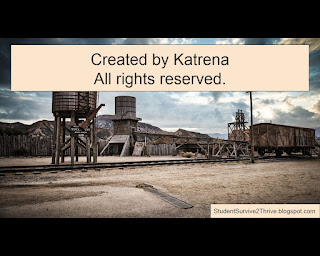 |
| Created by Katrena All rights reserved. |
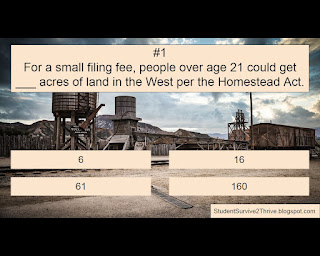 |
| For a small filing fee, people over age 21 could get ___ acres of land in the West per the Homestead Act. Answer choices include: 6, 16, 61, 160 |
 |
| The correct answer is 160. |
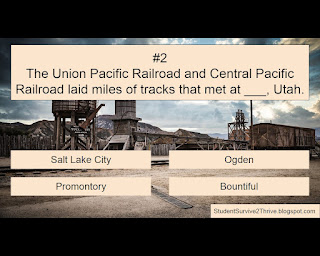 |
| The Union Pacific Railroad and Central Pacific Railroad laid miles of tracks that met at ___, Utah. Answer choices include: Salt Lake City, Ogden, Promontory, Bountiful |
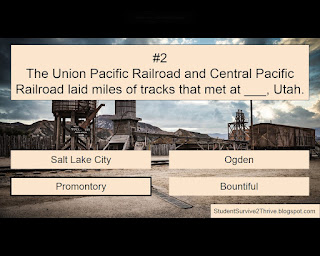 |
| The correct answer is Promontory. |
 |
| Several thousand African Americans migrated west after the Civil War and were called ___. Answer choices include: explorers, exodusters, dreamcatchers, sunset-runners |
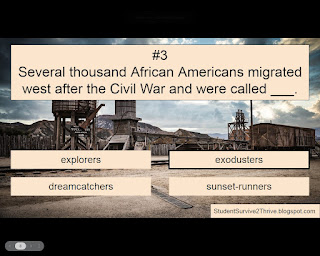 |
| The correct answer is exodusters. |
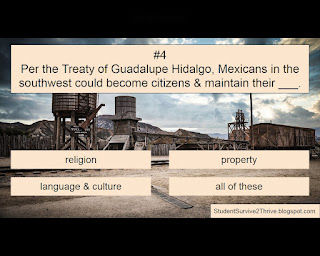 |
| Per the Treaty of Guadalupe Hidalgo, Mexicans in the southwest could become citizens & maintain their ___. Answer choices include: religion, property, language & culture, all of these |
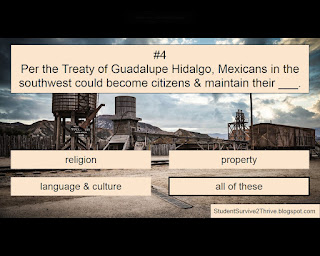 |
| The correct answer is all of these. |
 |
| Some farmers in the Midwest began to use ___ to draw water for their crops. Answer choices include: windmills, solar panels, slaves, drones |
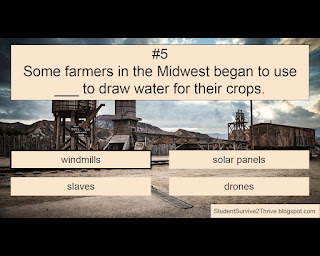 |
| The correct answer is windmills. |
 |
| Who wrote Little House on the Prairie? Answer choices include: Washington Irving, Laura Ingalls Wilder, Mark Twain, Jane Austen |
 |
| The correct answer is Laura Ingalls Wilder. |
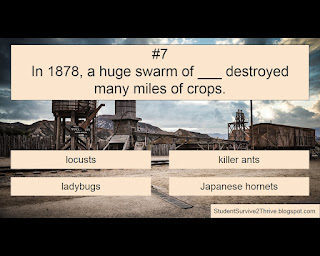 |
| In 1878, a huge swarm of ___ destroyed many miles of crops. Answer choices include: locusts, killer ants, ladybugs, Japanese hornets |
 |
| The correct answer is locusts. |
 |
| Railroads charged very low rates for farm equipment and livestock during the 1800s. Answer choices include: true, false |
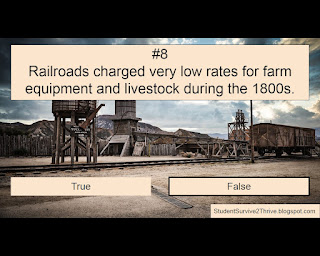 |
| The correct answer is false. |
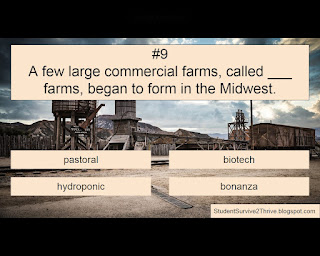 |
| A few large commercial farms, called ___ farms, began to form in the Midwest. Answer choices include: pastoral, biotech, hydroponic, bonanza |
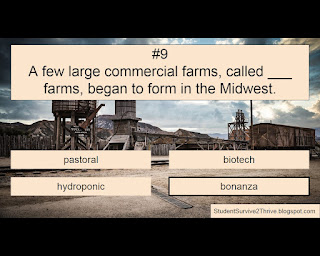 |
| The correct answer is bonanza. |
 |
| A typical farm wife would spend about __ hours/day doing household chores. Answer choices include: 2, 4, 7, 9 |
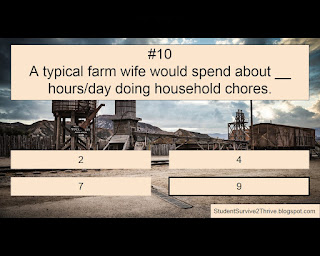 |
| The correct answer is 9. |
 |
| Which of the following was not a source of wealth for many in the Midwest in the 1800s? Answer choices include: gold, silver, copper, diamonds |
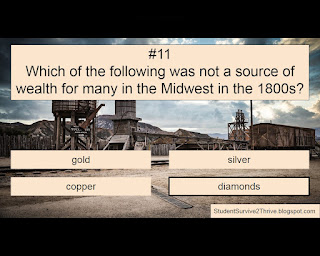 |
| The correct answer is diamonds. |
 |
| The completion of the ___ transformed the cattle industry in Texas in the 1800s. Answer choices include: Trail of Tears, Transcontinental Railroad, Panama Canal, Ring of Fire |
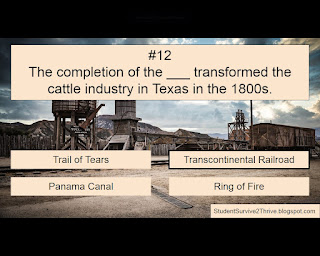 |
| The correct answer is Transcontinental Railroad. |
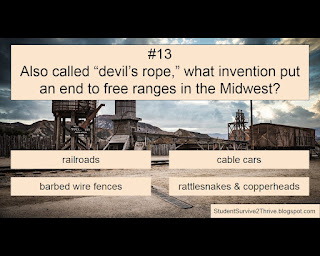 |
| Also called “devil’s rope,” what invention put an end to free ranges in the Midwest? Answer choices include: railroads, cable cars, barbed wire fences, rattlesnakes & copperheads |
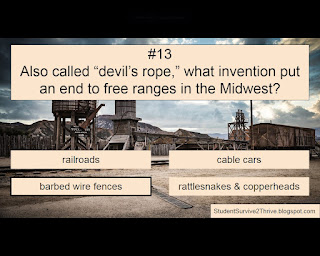 |
| The correct answer is barbed wire fences. |
 |
| The arrival of ___ brought more law and order to the Midwest towns. Answer choices include: Native Americans, Mexican Americans, women & missionaries, whiskey & rum |
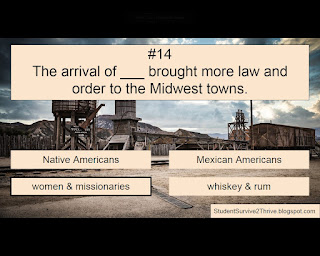 |
| The correct answer is women & missionaries. |
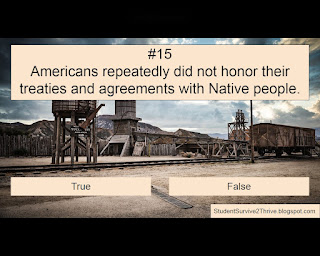 |
| Americans repeatedly did not honor their treaties and agreements with Native people. Answer choices include: true, false |
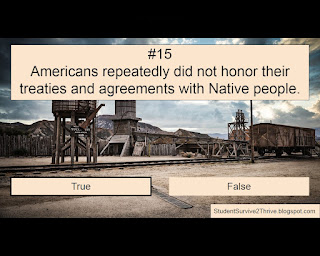 |
| The correct answer is true. |
 |
| Who led Native Americans to defeat Colonel George Custer’s troops at the Battle of Little Bighorn? Answer choices include: Sitting Bull, Geronimo, Tecumseh, Obwandiyag |
 |
| The correct answer is Sitting Bull. |
 |
| The correct answer is abandon their native culture. |
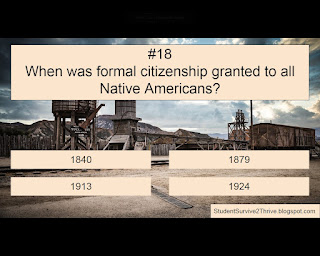 |
| When was formal citizenship granted to all Native Americans? Answer choices include: 1840, 1879, 1913, 1924 |
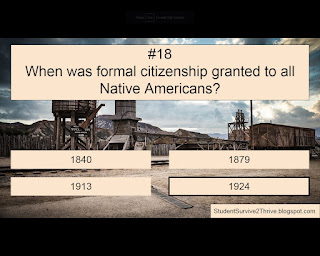 |
| The correct answer is 1924. |
 |
| What group of men primarily built the western railroad line? Answer choices include: Chinese immigrants, Native Americans, White Settlers, African Americans |
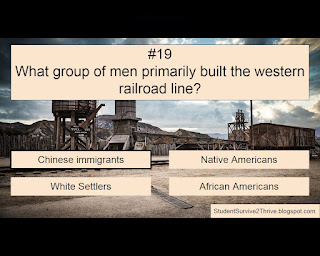 |
| The correct answer is Chinese immigrants. |
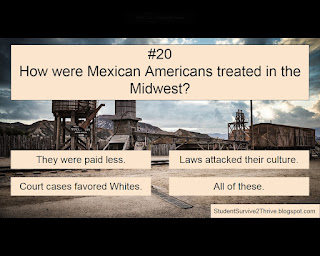 |
| How were Mexican Americans treated in the Midwest? Answer choices include: They were paid less. Laws attacked their culture. Court cases favored Whites. All of these. |
 |
| The correct answer is: All of these. |
 |
| Find more resources at StudentSurvive2Thrive.blogspot.com |

No comments:
Post a Comment
Thanks for reading my article and sending your comment! Please note that I do not place links to other web sites on this blog.
Note: Only a member of this blog may post a comment.